Snow-covered mountains, while presenting awe-inspiring beauty, are also zones of inherent risk, especially due to avalanches. The intricate dynamics leading to these natural disasters are complex and not fully understood. Recent research from TU Darmstadt and its collaborators has unveiled a new methodology that enhances our understanding of snow layers and their vulnerabilities, particularly focusing on what are known as “anticracks.” This article delves into the revolutionary findings of this research, highlighting their significance for avalanche prediction and prevention.
Avalanches are primarily triggered when a weakness forms within the layers of snow on a slope. Often, even the weight of a single person can impart enough pressure to destabilize these layers, initiating a catastrophic failure. Understanding the specific conditions that lead to such failures is imperative for the safety of mountain enthusiasts. Traditionally, the properties of these weak layers, particularly their fracture toughness, have remained elusive. The latest findings led by Dr.-Ing. Philipp Rosendahl and his team aim to bridge this knowledge gap through innovative experimental techniques.
The researchers have innovated a method to directly measure the fracture toughness of weak snow layers in a controlled field environment. This advancement is particularly crucial considering the unpredictable nature of snow behavior. Past studies provided insights but lacked systematic approaches to quantify the changes in fracture mechanics leading to avalanches. The research team aimed to create a methodology that could measure these properties under realistic conditions, providing a solid foundation for future avalanche predictions.
Dr. Rosendahl emphasizes the impetus for this research as stemming from advancements in both experimental and numerical avalanche studies. “Our study was motivated by the latest advances in avalanche research,” he remarked, pointing to the toolset that allowed them to study the mechanics of anticracking, which refers to the fracturing process that occurs in the weak layers of snow.
The experimental setup designed by the researchers includes a sled system fitted with blocks of snow containing weak layers. By applying controlled loads—both compressive and shear—the team was able to simulate the conditions under which snow layers fail. This meticulous approach allowed them to trigger and observe the propagation of anticracks under variable conditions.
One of the key findings from their experiments was the resistance to crack growth. Contrary to initial hypotheses that anticipated weaker responses under shear loads—since avalanches commonly occur in steep terrains where such forces dominate—the researchers found that the resistance was significantly higher under shear than under pure compression. This pivotal observation opens doors for re-evaluating how snow behaves under different loads, an area previously largely overlooked.
Furthermore, the methodology demonstrated that similar cracking behaviors could be observed in other porous materials, indicating broader implications. The discovery of a power law governing the conditions favoring crack propagation not only applies to snow but resonates across various fields, including aerospace engineering. This cross-disciplinary relevance is noteworthy, revealing how the study of snow can inform material science and structural engineering.
The significance of these findings cannot be overstated. Enhanced understanding of fracture mechanics in snow layers can lead to better predictive models for avalanche activity. Such models are crucial for early warning systems in avalanche-prone areas, potentially saving lives and minimizing property damage. Additionally, the study’s findings align with safety protocols for skiers, snowboarders, and mountaineers by providing vital information regarding the stability of snow around them.
Moreover, the experimental methods established by this research can aid in further studies beyond just snow. The correlations found between the behaviors of snow and other materials underline the importance of interdisciplinary approaches in studies of structural integrity.
The research led by Dr.-Ing. Philipp Rosendahl represents a significant advance in our understanding of snow dynamics and avalanche mechanics. By developing a systematic method to analyze the fracture properties of weak snow layers, this work not only enhances safety for outdoor enthusiasts but also contributes to broader scientific knowledge in porous material behavior. As we continue to face the challenges posed by natural disasters, such innovative research becomes increasingly vital in ensuring public safety and advancing our scientific understanding.


Leave a Reply